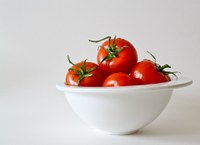Prairie Fare: Enjoy the Bountiful Tomato Harvest
(Click an image below to view a high-resolution image that can be downloaded)
By Julie Garden-Robinson, Food and Nutrition Specialist
NDSU Extension
“What does Jake have in his mouth?” my husband asked.
I looked out the window to see the latest thing our dog had found. He was shaking something bright red.
Oh, no! I hope he doesn’t have Carl the Cardinal, I thought to myself.
A vividly colored bird and his mate have been singing songs in our backyard all summer. We even bought them a special feeder. Now we host dozens of various birds for dinner in our backyard every night.
I ran outside and yelled, “Jake, drop it!”
He looked up at me guiltily and let go of the object. It wasn’t a bird, fortunately. It was a large, red tomato. I think it might have been from my “Mortgage Lifter” plant because the tomato was nearly the size of Jake’s head.
“How did he reach a tomato?” my husband said with a laugh. Our gardens are 3 feet off the ground and were built to keep rabbits and dogs out.
Tomatoes have grown well in the raised beds this year with the warm temperatures and rain. In fact, some tomato vines have grown down the sides of the garden boxes, leaving plump fruits hanging low enough for Jake and our two other dachshunds to grab a snack.
Fortunately, tomatoes are not harmful to dogs, but they shouldn’t eat the green parts of a tomato plant.
Tomatoes once were considered poisonous. Animal feeding behavior led to the discovery of whether fruits and vegetables are edible. Most likely, if they observed animals eating the items and surviving, people tried the food, too.
Tomatoes are rich sources of vitamins C and A, folate, potassium and other nutrients. They’re low in calories, too. Jake’s tomato had about 25 calories, I would guess.
Tomatoes get their red from a carotenoid pigment called “lycopene,” which has antioxidant properties that may protect us from heart disease and certain types of cancer.
All forms of tomatoes are healthful, but our body may be able to use the lycopene from cooked tomatoes in spaghetti sauce, for example, more easily.
Do you count tomatoes as “fruits” or “vegetables”? The answer depends on your perspective.
If you are looking at tomatoes as a botanist, yes, tomatoes are fruits. They’re “the mature ovaries of a plant.”
We in nutrition usually don’t think of fruits as “mature ovaries.” We classify foods based on their typical use in recipes and menus. Tomatoes generally are used in salads or pasta sauces, so we consider them vegetables.
Vegetables, on the other hand, usually are roots, stems and leaves. Carrots, celery and lettuce fit in those designations. However, in MyPlate, our latest nutrition guide, you’ll find squash, pumpkin and cucumbers in the vegetable section, even though, technically, they’re fruits.
Whether you call them fruits or vegetables, add more tomatoes to your diet. Besides red, tomato varieties are available in yellow, orange, pink, purple and green, and they vary in flavor.
In 2016, on average, we ate more than 21 pounds of tomatoes each. Have you eaten your share? Have some homemade salsa, a caprese salad (fresh mozzarella, basil and tomatoes), gazpacho (cold tomato-vegetable soup), grilled tomatoes or tomato juice.
Along with salsa, ketchup is a very popular condiment. Here’s a ketchup recipe from “Make Your Own Home-canned Condiments” (FN1861) available at https://tinyurl.com/ndsuextensioncondiments in a printable format, if you prefer. You also will find barbecue sauce, blender ketchup and taco sauce, along with relish and mustard, in the guide.
If you decide to make home-canned salsa, be sure to use a safe, tested formula. See https://www.ag.ndsu.edu/food/food-preservation/canning to learn more about canning salsa and other foods.
Country Western Ketchup
24 pounds ripe tomatoes
5 chili peppers, sliced and seeded
1/4 c. salt
2 2/3 c. vinegar (5 percent)
1 1/4 c. sugar
1/2 tsp. ground red pepper (cayenne)
4 tsp. paprika
4 tsp. whole allspice
4 tsp. dry mustard
1 Tbsp. whole peppercorns
1 tsp. mustard seeds
1 Tbsp. bay leaves
Wash tomatoes. Dip in boiling water for 30 to 60 seconds or until skins split. Dip in cold water Slip off skins and remove cores. Quarter tomatoes into 4-gallon stock pot or a large kettle. Add chili peppers and red pepper. Bring to boil and simmer 20 minutes, uncovered. Combine spices in a spice bag and add to vinegar in a 2-quart saucepan. Bring to boil. Turn off heat and let stand until tomato mixture has been cooked 20 minutes. Then remove spice bag and combine vinegar and tomato mixture. Boil about 30 minutes. Put boiled mixture through a food mill or sieve. Return to pot. Add sugar and salt, boil gently and stir frequently until volume is reduced by one-half or until mixture mounds on spoon without separation. Fill clean, hot pint jars, leaving 1/8-inch head space. Adjust lids and process according to the recommendations. Below 1,000 feet altitude, process in a boiling water-bath canner for 15 minutes. At altitudes of 1,001 to 6,000 feet, process for 20 minutes. Above 6,000 feet, process for 25 minutes. Yield: 6 to 7 pint jars.
Source: Adapted from the “Complete Guide to Home Canning,” Agriculture Information Bulletin No. 539, U.S. Department of Agriculture, revised 2009.
(Julie Garden-Robinson, Ph.D., R.D., L.R.D., is a North Dakota State University Extension food and nutrition specialist and professor in the Department of Health, Nutrition and Exercise Sciences. Follow her on Twitter @jgardenrobinson)
NDSU Agriculture Communication - Aug. 30, 2018
| Source: | Julie Garden-Robinson, 701-231-7187, julie.garden-robinson@ndsu.edu |
|---|---|
| Editor: | Ellen Crawford, 701-231-5391, ellen.crawford@ndsu.edu |



